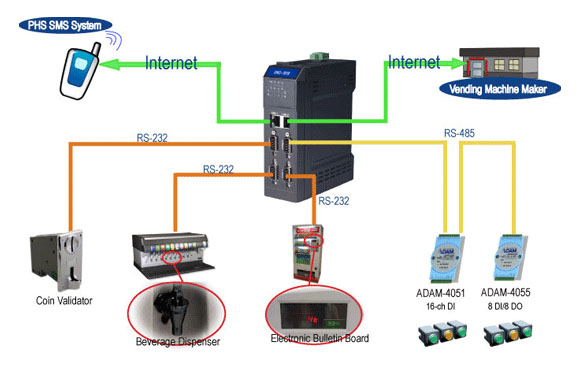|
 |
Issue Date: 2006/11/01 |
|
Vending Machine in Tokyo, Japan
|
Application: Facility Management
Location: Tokyo, Japan |
Project Introduction:
Since the 1880's when the first vending machines were introduced to dispense postcards, demand for these convenient product sales devices has increased rapidly. Vending machines have undergone drastic changes over the years, and just as with all devices in our society, are becoming smaller and more high-tech. The latest vending machines, for example, require CPU's and Ethernet ports, and at the same time they are being designed smaller to save space. With these requirements in mind, Advantech's UNO-1019 embedded platform is the perfect solution to be installed at the core of these units. |
|
|
System Requirements:
Vending machines have become small retail shops, and worldwide demand on these machines has increased rapidly. Recently, vending machines have begun to be developed with proprietary controllers, but due to the fact that many devices have different specifications and protocols, it's very difficult to integrate all of them into the same controller. Usually, manufacturers need to pay huge expenses for modifications or revisions to integrate all the required devices into one controller.
Our customer was seeking a controller with a PC-based open architecture which was easy to develop for, and easy to maintain. When they came to us, the choice was obvious; the UNO-1019 was the perfect solution. Aside from its open architecture, easy development structure and easy-to-maintain design, the UNO-1019 provides a compact form factor to save space in the tight vending machine architecture, allowing more space for product storage.
|
System Diagram:

|
System Description:
The coin validator, beverage dispenser and electronic bulletin board are connected to UNO-1019's serial (RS-232) communication ports. The ADAM-4051 and ADAM-4055 are connected to COM4 of UNO-1019 in serial RS-485 mode. Moreover, one Ethernet port is connected to PHS SMS system, and the other is connected to the manufacturer's server, providing consumers with two different ways to order products. The first is the traditional method, and this is when consumers put physical money into the machine, the coin validator checks the amount, and the electronic bulletin board displays this amount onscreen, giving the clear information for purchasing. Once the amount has been verified, the UNO-1019 will drive ADAM-4051 and ADAM-4055 modules to output the selected product. The new way to purchase products is via mobile phone. First, the consumer will send out a predefined SMS, then the PHS SMS system will verify it and then link to the manufacturers system, then the server will inform the UNO-1019 to complete this transaction, and drive the dispenser to output the selected product. In this method, the fee will be charged on the customer's mobile phone bill.
Conclusion:
Advantech's UNO-1019 is RISC-grade embedded platform that offers 2 LANs, 4 serial ports, and 4 digital inputs & outputs to fulfill I/O device expansion. Also, the UNO-1019 provides a CompactFlash for data storage, and its compact size saves installation space, allowing more room for other devices. By using a low power consumption CPU, CompactFlash® card and Microsoft® Windows® CE.NET, the UNO-1019 is a highly reliable embedded fanless controller that provides stability and performance. By adopting the UNO-1019, our customer has shortened manufacturing time, saved on development costs, and is able to leverage a PC-based open architecture into all of their new units, allowing all the serial device protocols to be easily implemented.
|
|
| |
| |
|
|
|
|
If you want to unsubscribe this eNewsletter, please send your mail to ia@advantech.com.tw
Thank you! |
| |
|
|
Copyright © 1983-2006 Advantech Co., Ltd. All Rights Reserved |
|
|
|